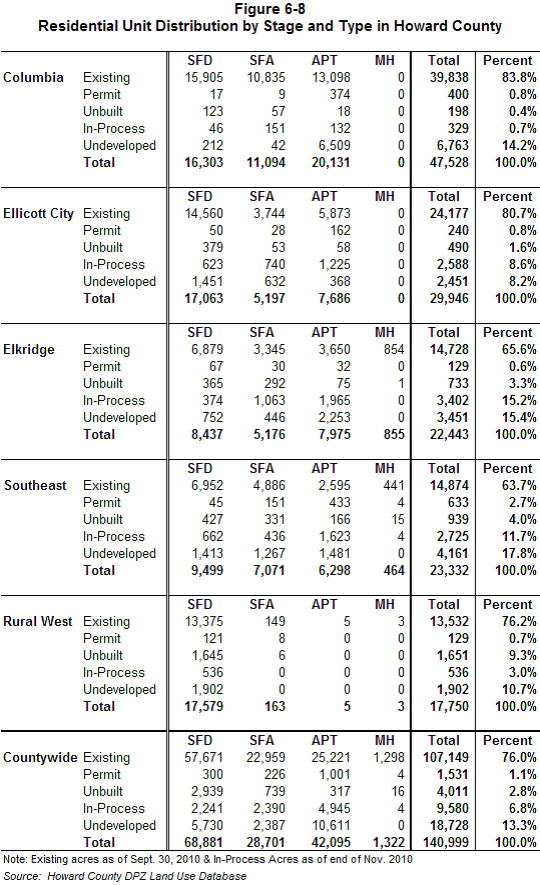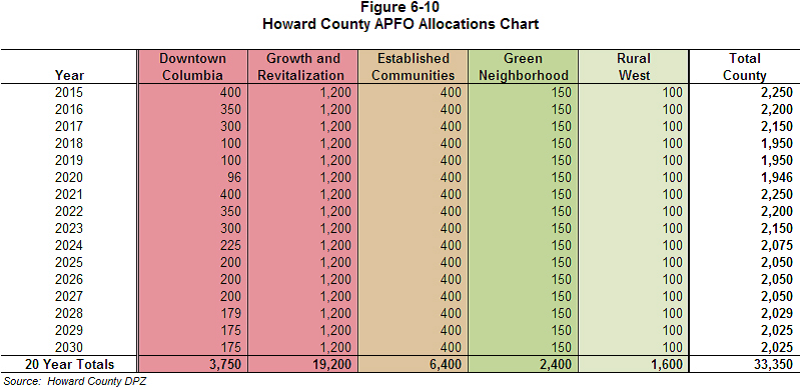Howard County APFO Needs Review and Action for our Future
Adequate Public Facilities Ordinance (APFO)
The Howard County Citizens Association (HCCA) is presenting this request to our elected officials. HCCA is asking that the Adequate Public Facilities Ordinance (APFO) be not only reviewed, but be completely revised to successfully manage the continuous growth in residential development in the County. There is a proverb that states, “Vision without Action is a Daydream – Action without Vision is a Nightmare.” We need to take the necessary action to ensure, whatever the vision, that it is fully supported by enforceable measures to promote the quality of life we all deserve. Our quality of life should not in any way deteriorate because we simply did not adequately plan.
Today APFO is not providing appropriate management of growth in the County. HCCA has testified and long supported changes to the ordinance. APFO has in many ways failed to satisfactorily support the County growth policy to create high density areas originally set aside as business, manufacturing and transportation corridors. This is adversely impacting established neighborhoods, towns and resident’s quality of life, especially in the targeted high density areas. All of these are challenged under the current version of APFO. For example: Howard County General Hospital reports that they average 77,000 plus patients going to the Emergency Department (ED) on a yearly basis as displayed on their website. All one has to do is go to the ED and witness the wait time at the ED and the number of patients lined-up on gurneys. If a patient is to be transferred from the ED to inpatient status, based on experience, the process can take anywhere from five to eight hours before being transferred. I recently experienced a family member who was transferred from the ED to the ICU and was there for four days. Two of those days were because there was no room available as an inpatient.
The school system has buckled and bent with the continuous reassessments and increases in the allowable number of students in existing schools with no brick or mortar changes to the foot print of the buildings. This has had a negative effect on the open/closed school chart making the chart more favorable to further development as the current APFO was not amended to deal with the higher number of students being placed in the schools.
APFO is riddled with exceptions and loop holes resulting in it having little teeth and little ability to manage the current planned growth in Howard County. The PlanHoward 2030 General Plan, shows the existing and planned residential units distributed by stage and type in Howard County (See Appendix A: Source: Plan Howard 2030 – Housing Allocation Chart – Figure 6-8). There are currently 107,149 exiting units or households in the county. The addition of the allotted development in figure 6-8 will take the number of units to 140,999 as a result of the 2004 comprehensive rezoning. There will be an additional 33,350 units or 100,050 more residents in the County by 2030 (See Appendix B – Source: Plan Howard 2030-Howard County APFO Allocations Chart – Figure 6-10) at 3 residents per unit or 66,700 additional vehicles at 2 vehicles per unit. The APFO chart in Figure 6-10 is a suggested and revised plan put forth by the Plan Howard 2030 task force and is only an estimate of how APFO allocates units today. (Please click the links or scroll down to see Figures 6-8 and 6-10). How will the current APFO manage this growth as it has been amended to reward or give advance allotments for different types of housing be it Moderate Income Housing Units (MIHU) or Leadership in Energy and Environmental Design (LEED) certified developments? The zoning law should manage the number of MIHU units and/or the LEED standards to qualify for any advanced allotments.
HCCA suggests that APFO be reviewed by a task force to rewrite the ordinance as soon as possible. APFO should simply be based upon input from an array of key quality of life measures to manage the number of available allotments and development in all parts of the County. The task force should consider the following key areas and obtain measurements where applicable to ensure a sound quality of life:
- The school system capacity in all areas of the County should be reviewed and the “Closed” percentage reduced to 100%. Allotments or development should not be granted until the school is below 90% for two consecutive years. Also High Schools should be added to the schools chart.
- Intersection, road and highway capacity must be taken into consideration with development permitted only if remediation is allowed and can be implemented before the project is completed. Remediation, when completed, should improve or not be lower than a grade of C for roads and intersections.
- The environment must be a qualifier in APFO including considering the need to develop buffers for our rivers and streams. Water management and sanitary solutions must be in place to handle proposed new development.
- There needs to be tests for ensuring the public is adequately protected by having enough police, fire, and emergency medical staff in place.
- The hospital must be able to handle the patient capacity whether it is in the ED or an inpatient setting. The hospital support across the County should be part of the test for allotments.
- There needs to be assurance that there are enough nursing homes and adequate staff especially regarding the doctor – nurse – technician to patient ratio.
- We need to ensure that our land-fills can handle the increase of trash due to an increase in growth.
- Our electrical grid system needs to support growth.
- There needs to be a full season environmental analysis to ensure species of trees, plants, and animals are not inadvertently destroyed or extinct.
The areas presented above are core to APFO and are key contributors to quality of life. Accelerated development adversely impacts these areas for both the residents and commerce of Howard County. HCCA believes APFO should reflect the Plan Howard 2030 General Plan in order to effectively manage growth and density in the County.
HCCA would like the next administration and our legislative leaders in the County to bring forth a group to review APFO as it reads today with the objective of contributing toward managing a better future and ensuring our quality of life will in no way deteriorate because of poor planning and weak APFO measurements. We realize that some of the aforementioned issues are controlled by the State, but the County needs to face the problem and work with the State for the betterment of all.
The Howard County Times wrote an editorial on 10 April 2014 that aligned with HCCA’s position. The title was “Time for Howard’s Adequate Public Facilities Ordinance to be reviewed.” In the editorial it states, “Carroll, Montgomery, and Prince George’s counties consider, in one fashion or another, the impact of a growing population has on police, fire, emergency medical services and in the case of Montgomery, health clinics. At a time when government budgets are stretched, these public needs should be addressed in APFO. Perhaps public hearings in early 2015 would be a place to start.” The editorial went further by stating, “Development can’t and shouldn’t stop in Howard. It is a strong engine that keeps the county economy chugging along. But development cannot put undue strain on the county’s resources. That’s why we need a strong APFO.”
It is for the reasons above that the HCCA would like the opportunity to work with our County officials to enable a better place for Howard County today and in the future. We simply can no longer afford major growing pains that we cannot recuperate from because of an inadequate Adequate Public Facilities Ordinance policy.
Sincerely,
Stu Kohn
HCCA, President
Appendix A – Source: PlanHoward 2030 – Housing Allocation Chart – Figure 6-8

Figure 6-8 also shows existing units, permitted units (those under construction), recorded unbuilt lots, in-process units (those with a subdivision or site plan under review), and undeveloped units. About 45% of the additional 34,000 units allowed under current zoning are either in-process, recorded but unbuilt, or permitted. Consequently, the exact location and type of these units is already determined. They include a significant number of larger phased plans in the Route 1 Corridor. Note that many of these in-process units have been delayed over the past three to four years due to the recent economic downturn. Including the 5,500 Downtown Columbia units (which are counted in the undeveloped category), more than 60% of future housing units are known in detail, including location, type, and likely phasing.
Appendix B – Source: PlanHoward 2030 – Howard County APFO Allocations Chart – Figure 6-10
PlanHoward 2030 proposes to simplify allocation distribution. Figure 6-10 shows how APF Housing allocations will be used to pace growth through 2030. Only five allocation pools are proposed: Downtown Columbia; Targeted Growth and Revitalization; Established Communities; Green Neighborhood; and the Rural West. The Downtown Columbia, Targeted Growth and Revitalization, Established Communities, and Rural West areas are shown on Map 6-2. Green Neighborhood allocations can be granted anywhere in the PFA for development meeting green neighborhood design standards. Allocations are granted at the initial planning stage when sketch or preliminary plans are first reviewed by DPZ. Since it typically takes several years from initial plans to the construction and occupancy of all units in a project, allocations are granted three years in the future per the APF law. The first allocation year in Figure 6-10 is thus 2015, three years after the 2012 adoption year of PlanHoward 2030.

